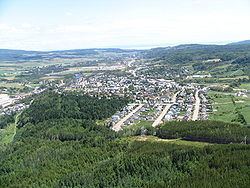Country Canada Constituted February 16, 1935 Postal code(s) G4A Area 52.3 km² Province Québec | Settled 1800 Time zone EST (UTC−5) Area code(s) 418 and 581 Population 3,118 (2011) Local time Monday 10:19 PM | |
 | ||
Weather -10°C, Wind N at 8 km/h, 73% Humidity | ||
Clermont is a ville in the Canadian province of Quebec, and the seat of government for the Charlevoix-Est Regional County Municipality. It is located on the southern banks of the Malbaie River.
Contents
Map of Clermont, QC, Canada
History
Around 1800, the first settlers moved into the area, living primarily of agriculture. Followed by a saw and flour mill, tradeshops, and stores, a settlement grew that was then known as Chute Nairne. At the close of the century, the place attracted attention for its hydro-electric potential, and by 1900, a dam was built across the Malbaie River, supplying electricity to La Malbaie and surrounding area.
In 1909, Rodolphe Forget founded the East Canada Power and Pulp Company, and wanting to profit from the phenomenal growth in the pulp and paper market, he built Chute Nairne's first paper mill in 1911. The industrial development changed the place from a rural and agricultural society to a rapidly growing urban community.
Félix-Antoine Savard, famous Québécois author and at that time priest of the Parish of Saint-Étienne in La Malbaie, was also responsible for Chute Nairne. His parishioners there were upset about being left a bit to themselves and about being far away from the parish church. Savard, at the request of residents of Chute Nairne, petitioned the bishop of Chicoutimi, Charles Lamarche, to obtain permission for a new parish and church. The request was accepted on September 18, 1931, and the Parish of Saint-Philippe-de-la-Chute-Nairn was formed.
On February 16, 1935, the place separated from La Malbaie and was incorporated as a municipality, officially adopting the name Clermont for the new municipality. Félix-Antoine Savard greatly admired and paid tribute to Blaise Pascal who came from Clermont-Ferrand in France.
In 1949, Clermont changed its status to village and in 1967 to town.
Population
Private dwellings occupied by usual residents: 1,393 (total dwellings: 1,437)
Mother tongue:
Economy
Clermont's economy centres on the Abitibi-Bowater paper mill, formerly the Donohue mill that was founded in 1936 by the brothers Timothy and Charles Donohue and employed close to a thousand people in the 1970s.
Clermont is also the end of the Charlevoix Railway and therefore is an intermodal freight transport hub primarily for wood.
